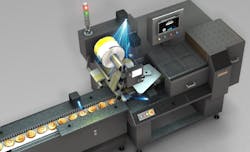Vibration sensors provider VocalZoom (VZ) recently launched autonomous sensors for the Industrial Internet of Things (IIoT). Combining contactless, high-resolution vibration sensor technology with built-in data processing and wireless communications, the company’s new product offers low-cost and fast deployment of a wide range of monitoring applications for IIoT environments, providing manufacturers with crucial operational and technical insights.
VZ’s laser sensors measure 3D, motion and vibrations of any surface to enable industrial manufacturers to monitor the real-time health and performance of engines, turbines, pumps and more. The compact and contactless form enables the sensors to work on hot, wet, and moving surfaces, and they even continue to analyze mechanical health through glass. VZ’s Autonomous Sensors also include built-in real-time data processing and decentralized data logic powered by Ucontrol’s uPC platform, offering a standalone solution for edge processing and data analytics. The system can connect to a computer in the manufacturer’s production line or to an internal or external cloud.
“We believe data from next-generation sensors will shape the future of industrial IoT by reducing the cost of implementation, solving new use cases, and helping factories become smarter and more efficient,” said Tal Bakish, VZ CEO. “Our autonomous sensors revolutionize the IIoT by providing a complete monitoring and edge processing solution in a single, compact package that saves manufacturers time and money while providing the most accurate monitoring possible.”
Combining a patented sensor and data processor into one unit allows the Autonomous Sensor to measure and analyze results without the need for additional products. This makes it a more affordable alternative to many other solutions on the market. Even while calculating RPM, thickness, vibration anomalies, existence, height, rotation, homogeneity, weight, and flow, the optical sensors don’t influence the product, resulting in more accurate readings. Unlike traditional monitoring systems, the sensors are not susceptible to ambient noise or vibrations and can be deployed quickly and easily practically anywhere in an IIoT setting without any downtime.
Bakish tells IndustryWeek, it plans to leverage 5G later in 2021 when it expends the applications supported, especially in outdoor environments such as oil and gas as well as power and energy. Most existing VZ customers utilize WiFi.
About the Author
IW Staff
Find contact information for the IndustryWeek staff: Contact IndustryWeek
